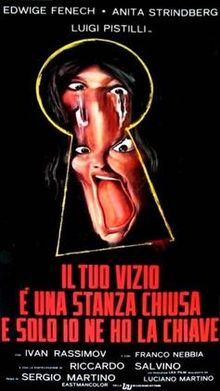
I LOVE GIALLO FILMS and decided to revisit 10 for Halloween this year. Giallo is the Italian term for mystery fiction and thrillers, particularly murder thriller films with a horror/exploitation bent.
The origins of giallo are rooted in a series of mystery books that began in 1929 all printed with yellow (giallo) covers to differentiate them, but in the ’60s and start of the ’70s, they became a film subgenre thanks to directors Mario Bava and Dario Argento.
Giallo films typically feature mysterious killers with mysterious motives, often wearing black gloves and masks to hide their identities and frequently unclothed women victims and femme fatales.
Blackmail, sexual exploitation, a victim often suspected as the killer and identity turnabouts abound in the giallo, which often have plot twists that will leave your jaw hanging open.
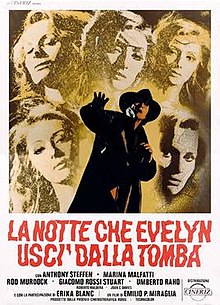
I own dozens of giallo films and decided to revisit some that I haven’t seen in awhile this month, which is great because I have a bad memory.
I rarely remember the core plot points of books and films a few weeks after enjoying them … so most of these felt like seeing them for the first time for me! I started watching the films on this list 10 nights before Halloween, and decided each night on the spur of the moment what to watch… so the countdown is not about the quality of the films from worst to best, but rather, a night-by-night Countdown to Halloween!
My thumbnail reviews on each film I watched follow:
#10 THE BLOODSTAINED BUTTERFLY
Director Duccio Tessari may be more known for his Italian Westerns, but in 1971, a banner year for giallo films, he made this interesting entry to the genre. It opens with a mysterious stabbing murder of a young college student in a park during a rainstorm. A TV personality is tagged as the killer, and we soon learn that his lawyer, who presents a half-hearted defense, is having an affair with the accused’s wife.
It’s a good setup, but honestly, the 45 minutes of police procedural and courtroom drama in the middle drag a bit. It’s worth sticking it out though for the surprising endgame, when we find out who really killed the girl (and the other two murders that occur during the film). This is not one of my favorite giallo films, but there are some well-shot scenes and it stars Helmut Berger. If you’re a giallo fan, it’s definitely worth checking out. If you’re not a raving fan… it’s probably not the film I’d suggest you start with.

5 out of 10 black-gloved fingers!
#9 SHORT NIGHT OF GLASS DOLLS
The second entry in my countdown to Halloween was made in the same year as yesterday’s film (1971 was a very good year!). So, watching the extras of last night’s film, I discovered that this was originally supposed to be titled Short Night of the Butterflies, but thanks to the release of the movie I reviewed yesterday — The Bloodstained Butterfly — they renamed it just before releasing. Odd to have accidentally watched them back to back!
This features an alluring score by the always dependable Ennio Morricone, who always leaves you humming the theme hours later. It was Director Aldo Lado‘s first film and that may explain some of the more uneven spots when it drags a bit in the middle. It wins back points for a bizarre concept — the “narrator” is basically a corpse; American reporter Gregory Moore (played by Jean Sorel) is brought to the morgue but he is still trapped in his “dead” body. He tells the film in a series of flashbacks about the mysterious disappearance of his girlfriend Mira (the striking Barbara Bach). The film follows his search for Mira which leads him to strange places including a house on stilts inhabited by a blind man and the discovery of an Eyes Wide Shut kind of secret elders society. But people are watching him, as informants and friends around are killed as he circles closer to the answer. The answer, by the way, despite lots of build, still comes completely out of left field, almost as if Lado grabbed the end of a horror exploitation film and spliced it in.
Bach is alluring and Sorel is a strongly sympathetic detective lead. There are enough odd moments and unexpected deaths to keep you wondering as Sorel tries to figure out what has happened to his girlfriend… while periodically commenting as his corpse is wheeled around the morgue and taken into the OR for attempted resuscitation before being brought to a medical theater for… the end? The ending is a chilling bit of “oh no” that will have you rewinding to watch it again. At least I did.

7 out of 10 black-gloved fingers!
#8 BLACK BELLY OF THE TARANTULA
The third entry in my countdown to Halloween was made in 1971, the same year as the last two I reviewed. This giallo is notable for both an inventive “kill” conceit as well as for having three Bond girls in the cast — Claudine Auger (Thunderball), Barbara Bach (The Spy Who Loved Me) and Barbara Bouchet (the original Casino Royale). In addition, the lead actor, Giancarlo Giannini, played Matis in the two most recent Bond films! All that said… this is not a Bond film…this is an early giallo with a mystery, murders and blackmail scheme at its core.
This one finds a mysterious killer attacking women with surgical gloves and killing them by paralyzing them with an acupuncture needle before slicing their bellies open with a knife while the victims are still alive but frozen (akin to the way tarantuals are killed by wasps). The idea is great, but honestly is a little underplayed here. Giannini is great as a detective who is having huge doubts about his career, particularly when he is unable to save victims involved in the case — which somehow ties back to a spa and a smuggling ring. This one is directed by Paolo Cavara, who only made a couple giallos. He started out doing mondo documentaries in the ’60s and then moved into doing a handful of genre westerns, comedies and giallos in the ’70s. This features another score by the seemingly ubiquitous Ennio Morricone.

7 out of 10 black-gloved fingers!
#7 PLOT OF FEAR
Last night’s rewatch of Black Belly of the Tarantula made me curious to revisit director Paolo Cavara‘s other giallo, 1976’s Plot of Fear. While I’ve seen both of Cavara’s giallo films before, it was interesting to watch them back to back. Both feature unusual plotlines for a giallo, and both follow an inspector as he tries to unravel a convoluted mystery. And oddly enough, while Cavara’s first giallo featured three past and future “Bond girls,” his second ALSO features a future Bond girl in Corinne Cléry (Moonraker). Maybe the casting folks at Eon Productions had an in with Cavara.
In this outing, our Inspector (played by Michele Placido) is trying to figure out how a man strangled in his home by an S&M prostitute is connected with a woman killed by a wrench to the head on a bus since the killer left cutouts from a children’s book at each crime. Eventually, he finds himself at an empty now-disbanded club called Wildlife’s Friends, where Jeanne (Corinne Cléry) tells him about the decadent Eyes Wide Shut-style parties that occurred there, including the girl who was scared to death when they threatened to feed her to a tiger.
There are plenty of red herrings and the end had me rewinding to figure out what I missed. But there are enough quirky scenes that I found it just a hair more satisfying than Black Belly of the Tarantula.

7 out of 10 black-gloved fingers!
#6 YOUR VICE IS A LOCKED ROOM AND ONLY I HAVE THE KEY
The fifth entry in my Italian horror/thriller countdown to Halloween is from one of my favorite giallo directors featuring one of my favorite giallo actresses. Director Sergio Martino filmed some of the best giallos and this, his fourth, released in 1972, references his first (The Strange Vice of Mrs. Wardh) in its title, as well as employs the same actress, the always alluring Edwige Fenech, in a turnabout kind of role for her.
The film introduces us at the start to an abusive, alcoholic, washed up writer (played to the hilt by Luigi Pistilli), who taunts and demeans his wife at drunken parties and has some strange fascination with his dead mother and one of her dresses. Meanwhile, his wife (played by giallo regular Anita Strindberg) not only puts up with his degradations but also fights with Lucifer, his dead mother’s black cat. When a former blackmailing fling of the writer is killed with a scythe on a night he was supposed to rendezvous, he’s easily the first suspect. It’s not long before his housekeeper (who he has also sexually abused) is slashed under his own roof. When he insists to his wife that the killer is not him but that he will be locked up if they don’t hide the body, she helps him secrete the dead woman behind a wall in the wine cellar of their crumbling mansion. Sound a little familiar? This one uses several riffs from Edgar Allan Poe’s “The Black Cat,” but they’re nods to the source, not a production of that story.
This one has plenty more twists in store. When the writer’s niece, played by Edwige Fenech, turns up to stay in the crumbling mansion with them, she soon is playing sexual games with both husband and wife, but what is her motive?
The final scene is one of the best twists in a giallo, and even though I’d seen it before… I had totally forgotten it, so I was grinning ear-to-ear when it watched it again last night. There are good things about not having a good memory! I rewatched all of Martino’s other gialli earlier this year, so I’m glad I saved this one for Halloween week. Great characters, lurid scenes, unexpected twists. Highly recommended!

9 out of 10 black-gloved fingers!
#5 THE CASE OF THE BLOODY IRIS
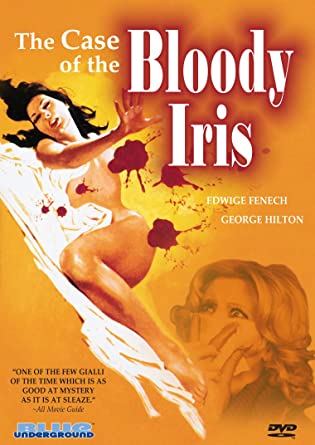
Also known as Why Those Strange Drops of Blood on Jennifer’s Body?, this 1972 giallo was directed by Giuliano Carnimeo and stars Edwige Fenech as Jennifer, a fashion model drawn into the orbit of Andrea, an architect who seems to have amazing luck at being in the wrong place at the wrong time… at least as far as murder is concerned. He’s played with likeable brooding by giallo regular George Hilton (who also appeared with Fenech in The Strange Vice of Mrs. Wardh).
After attending one of her photoshoots, Andrea is drawn to Jennifer and helps get her and her daffy friend (think Laverne with a better figure) an apartment in one of his buildings. As it turns out, the reason the apartment is empty is because it is where a girl has just been murdered in the bathtub, shortly after she found the body of a call girl murdered in the elevator. Soon another woman of questionable repute (she wrestles half nude with men in a special “members only club”) is also found dead… shortly after having dinner with Andrea. Hmmm.
We quickly learn that Jennifer’s new apartment could really use a better set of locks. She wakes up one night with a black-hooded man over her bed. Then her ex-husband, a sex cult leader who is stalking her throughout the film and leaving the title’s shredded iris petals all over, corners her there and rips her clothes off. And then a black-hooded figure again turns up to ruin her wardrobe. She handles all this amazingly well as the viewer is asking… Is Andrea behind it? Is it the mysterious male voice next door, who the old woman who buys horror magazines insists does not exist? Is it the neighbors on the other side — the weird old violinist or his flirtatious yet somehow cool lesbian daughter?
This film is filled with wild characters, frequent compromising situations, often unintentionally silly dialogue, a police chief who looks for postage stamps for his collection as much as evidence at the murder sites and virtually everyone we meet is a suspect. It is a ton of fun and hits all the buttons for me. Plus it has one of my favorite themes in giallo films, thanks to Bruno Nicolai.

9 out of 10 black-gloved fingers!
#4 THE CAT O’ NINE TAILS
You can’t have a giallo list without talking about Dario Argento, who is largely responsible for popularizing the style that Mario Bava started in the ’60s. I’ve been trying this week to not simply watch “the greatest hits of giallo” though, so it took me all this time to hit on one of the master’s entries. (I watched his first one not too long ago, so that’s why I didn’t “start at the beginning”).
Cat o’ Nine Tails was Argento’s second film (ironically, like so many others on this list, released in 1971), and is the middle in his “animal giallo” trilogy that started with The Bird with the Crystal Plumage and ends with Four Flies on Grey Velvet. These films are not related other than the style of the title, which Argento says he stopped doing because everybody else started doing it (see Butterfly and Tarantula earlier in this list).
This one is far less exploitative than many of the giallos on this list; the sexual element that most giallos include really only pops up in one scene, because the story doesn’t really call for it. The focus of the story is on an older blind former journalist (Karl Malden) who overhears a conversation about blackmail while on the street with his young niece (who serves as his eyes), and not much later hears a murder happen on the street below his apartment. The next day he meets a reporter played by James Franciscus investigating the murder, as the body was discovered in a genetics research complex at the end of the block.
Soon the blind man and reporter are teaming up to try to solve the crime. It’s a fun pursuit for Malden’s character, who has been confined by the loss of his sight to solving physical puzzles. Meanwhile, someone is at work knocking off anyone who might have insight into the crime, and soon both the former and current reporter are in the sights of the killer…and it’s no longer a game.
This one offers some science fiction overtones (the genetics lab is working on solving a chromosonal predisposition towards violence), some suspenseful strangling and stabbing, a nailbiting scene of graverobbing (for clues!) and a car chase that leaves our intrepid reporter a bit ashen. It’s a great Hitchcockian story with a soundtrack by Ennio Morricone, and a perfect introduction to the giallo if you’ve never seen another.

8 out of 10 black-gloved fingers!
#3 SEVEN BLOODSTAINED ORCHIDS
Director Umberto Lenzi filmed several giallos in the late 60s/early ’70s before turning to straight-up police crime dramas. His giallo thrillers are all great, and 1972’s Seven Blood-Stained Orchids seemed like a good choice to revisit this week, since I watched another “bloody flower” movie just a couple nights ago!
This one opens with its most exploitative scene — a prostitute is solicited and then brutally bludgeoned to death (naturally after having been stripped) in a field not far away. The killer leaves a half-moon pendant in her hand.
Soon, another woman is attacked in one of the creepiest scenes in the film, as she realizes someone is in the house, and someone has poisoned the milk of her cats while she was just in the other room. This one will leave you squirming as she moves into the killer’s sights. She is later found with the same pendant.
Then, newlyweds Mario (Antonio Sabato) and his wife Giulia (Uschi Glas) are on a train when the killer tries to strike again. This time, however, his victim doesn’t die… but the police let the newspapers report that she did to protect her as a bitter, chip-on-his-shoulder cop tries to solve the case. Mario, however, takes matters into his own hands, and runs a sleuthing investigation of his own with his wife, naturally managing to run down more leads than the police. He and Maria eventually figure out the thread that binds the victims together, and enter a race against time to save the remaining women who are also on the killer’s list, while trying to figure out who the killer is.
Amateur sleuths are always a fun conceit and Mario’s walk into a hippie-drug party in a wildly decked out apartment as part of his search is worth watching the movie for all by itself (groovy, man!) The identity of both the killer and the reason for the murders plays out as a pretty good surprise. This is a solid murder mystery with some truly gorgeous scene setups. The score in this one is by Riz Ortolani and captures that entrancing ’70s Italian feel.

8 out of 10 black-gloved fingers!
#2 THE NIGHT EVELYN CAME OUT OF THE GRAVE
Director Emilio Miraglia‘s Evelyn is not your typical giallo… in fact, for the first 30 or 40 minutes, it doesn’t feel like a giallo at all but more like a sexy gothic horror film, given that it takes place in a crumbling castle with a “whips and chains” room. We KNOW who the killer is — our lead character Lord Alan Cunningham, played by Anthony Steffen (who gained fame through Spaghetti Westerns).
It seems that Lord Cunningham has lost his beautiful but unfaithful red-haired wife, Evelyn, and the loss drove him to the madhouse. Now he’s out… but he keeps having gauzy memories of Evelyn running naked through a field to meet a lover… plus, he has developed a bad penchant for picking up red-headed hookers (like Susan, played by horror/giallo star Erika Blanc), getting them to strip in his dungeon and put on black boots, and then killing them. So much so that he keeps a set of spare license plates on the car so he can’t be identified as the “pickup guy” later. Seems like it’s going to be a pretty quick story.
But then… he takes a holiday in London and meets Gladys, a pale reddish haired girl (Marina Malfatti) at a party… he asks her to marry him that very night and suddenly… our murderous psycho is cured by amorous and frequently unclothed matrimony… except that he still keeps a giant portrait of his dead wife in full view of the marriage bed and has episodes where he thinks he sees or hears her ghost.
Things get weirder then, as his wife runs into a red-headed maid in the kitchen when Cunningham has forbidden any other redheads to be in the house. And then a couple of the relatives living with him are bumped off by someone in creatively creepy ways. Someone is taking revenge on the House of Cunningham… could it be Evelyn returned from the dead?
The result is a final half hour that has twists within turns within twists. What do you call a double-cross times 3 or 4? You can write it all off as a crazy nonsensical film with not a single redeemable character but… I love it more every time I watch it. This one was (again) shot in 1971 like so many others on this list and features a score by Bruno Nicolai.

8 out of 10 black-gloved fingers!
And the final film is…
Today is Halloween! All week I’ve been canvassing Italian giallo films from the early ’70s in my DVD collection that I’ve loved. I’ve tried to stay away from simply watching “the greatest hits”, so there’s been no Bava or Fulci and only one early Argento. Most, ironically, turned out to be from 1971 (wasn’t planned, just turned out that way). Last night’s final entry in my countdown to Halloween is:
#1 DEATH WALKS ON HIGH HEELS
This 1971 giallo directed by Luciano Ercoli is another solid “who is the killer” mystery written by Ernesto Gastaldi, who seemed to write half of the great giallos produced in Italy in the early to mid-’70s.
This one stars Ercoli’s future wife, Nieves Navarro (credited as Susan Scott) as Nicole, a French stripper who is the daughter of a recently murdered jewel thief at the start of the film. She and her down-on-his-luck boyfriend (played by Simon Andreu) are questioned by the police to find out if she has knowledge of where the jewels are and she says she has not spoken with her father in ages.
Shortly afterwards, she begins receiving menacing calls from someone with a mechanical voice altering device threatening her life if she doesn’t produce the jewels. And then she is threatened with a razor-wielding man dressed all in black with electric blue contacts who has broken into her apartment. It’s a warning… next time… she will be killed if she doesn’t hand over the jewels.
She flees to her boyfriend’s apartment, where the next morning she discovers blue contacts in the medicine chest… and believing him to be her attacker, she flees the country, hooking up with an older doctor (played by the instantly affable Frank Wolff in what was sadly one of his last roles — he committed suicide later that year). Doctor Matthews had been showing up at her striptease shows and she had previously rebuffed his advances, but when she sees him in a hotel lobby, she uses him to escape the country. He sets her up in a small town “love nest” cottage in coastal England and promises to marry her once he has divorced his wife.
Here’s where the film starts getting tricky… someone shoots (but doesn’t kill) the doctor, Nicole goes missing after someone is seen entering the cottage late at night, and the boyfriend from France shows up in town having tracked her down. The core of this mystery unravels like an awesome rollercoaster ride that hits the finish at full speed. The body count is not large, but it’s great fun and well worth a watch!

9 out of 10 black-gloved fingers!
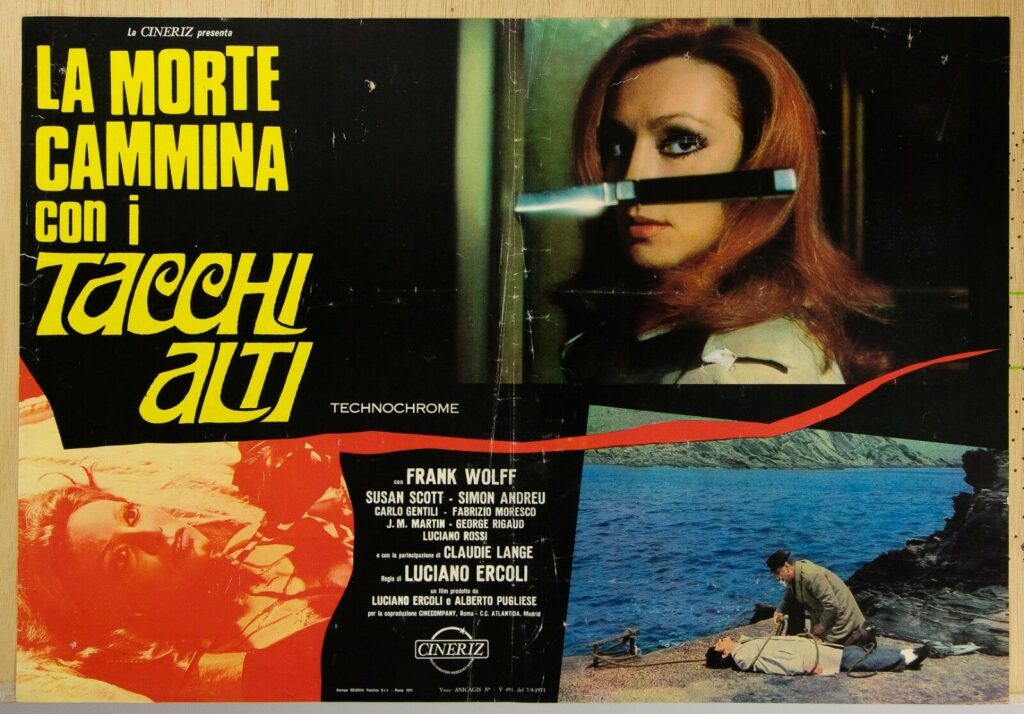






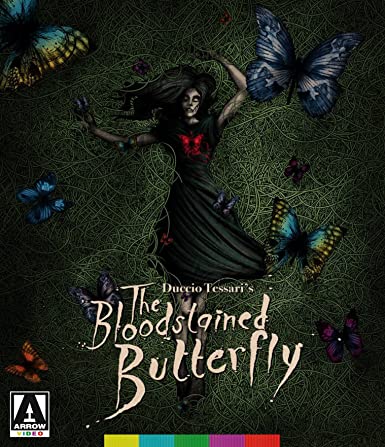

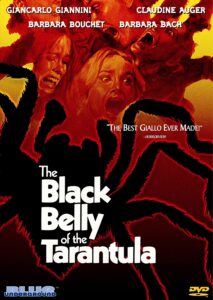
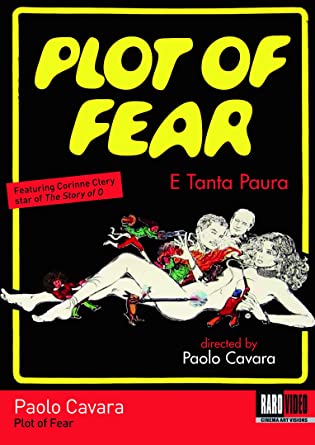
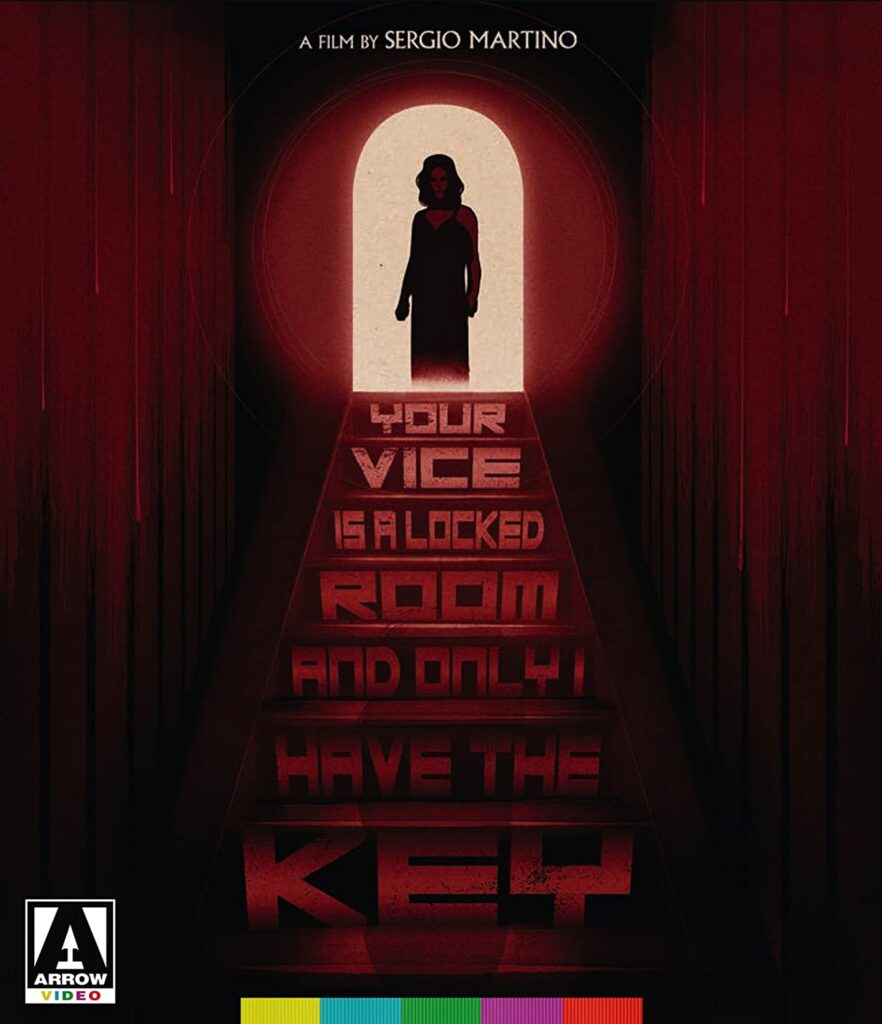
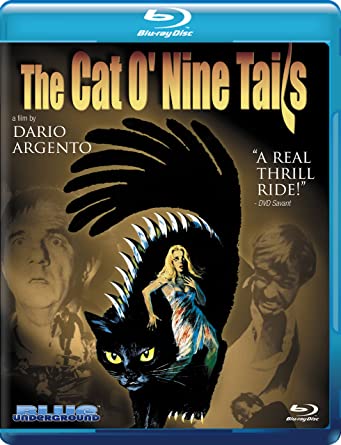
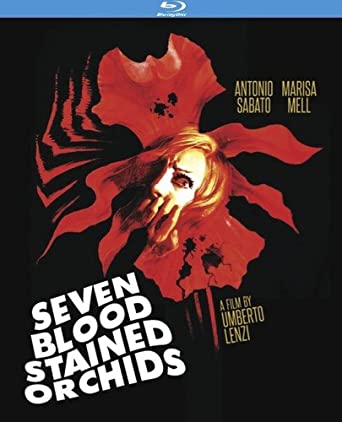
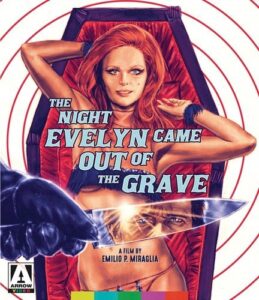
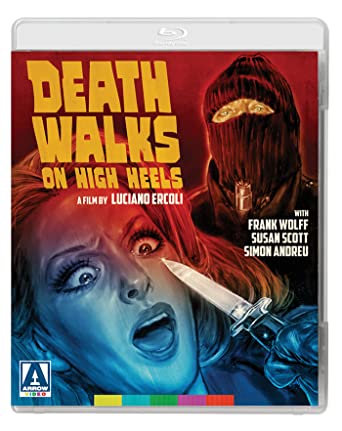

Pingback: Goodbye 2020. No, really... Goodbye. Get lost. ~ John Everson
Pingback: 21 Nights of Giallo: Week One ~ John Everson
Pingback: 21 Nights of Giallo: Week Two ~ John Everson
Pingback: 21 Nights of Giallo: Week Three ~ John Everson